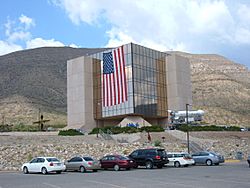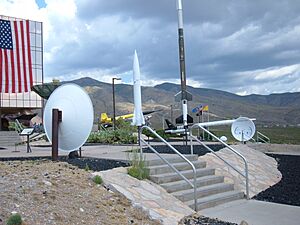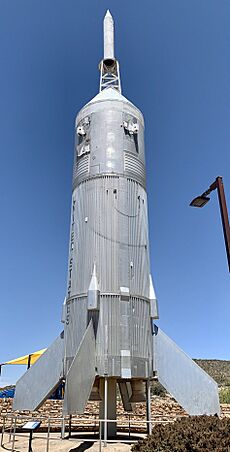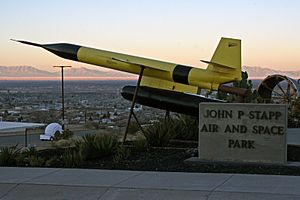New Mexico Museum of Space History facts for kids
 |
|
| Established | October 5, 1976 |
|---|---|
| Location | Alamogordo, New Mexico |
| Type | Aviation museum |
| Visitors | 5,034,369 to date as of July 1, 2013 |
The New Mexico Museum of Space History is an exciting place in Alamogordo, New Mexico. It's a museum and planetarium all in one! This museum is all about space flight and the amazing things that happened during the Space Age. It even has a special area called the International Space Hall of Fame.
The museum shows how much New Mexico helped the U. S. space program. It's one of eight museums managed by the New Mexico Department of Cultural Affairs. The museum has been recognized by the American Alliance of Museums since 1993. It is also connected with the famous Smithsonian Affiliate museums.
A very special resident at the museum is Ham. Ham was a chimpanzee who made history in 1961. He was the first great ape to fly into space!
Contents
Exploring the Museum: Exhibits
Inside the Main Building
The main museum building has lots of cool things to see. You can learn about the different planets in our Solar System. There are also exhibits about space flight itself. You'll even find out about the primates (like monkeys and chimpanzees) who helped with early space experiments.
The museum has copies and training models of important space items. These include satellites, the Space Shuttle, and the Apollo Lunar Module. The real ones are either still in space or on the Moon!
Outside the Main Building
The Clyde W. Tombaugh IMAX Theater and Planetarium is a big dome. It shows amazing IMAX movies and also projects stars and planets like a planetarium. You can watch IMAX films there every day.
The Hubbard Space Science Education Building opened in 1991. This building holds the museum's library. It also has small archives and offices where curators work. Curators are people who take care of the museum's collections.
The Museum Support Center is a separate building. It's like a big workshop and storage area. Here, museum staff get items ready for display.
Outdoor Exhibits and Memorials
The John P. Stapp Air and Space Park is an outdoor area. It has large space artifacts. One cool item is the Sonic Wind No. 1 rocket sled. This sled was ridden by John P. Stapp, who studied how fast things could go.
Ham, the chimpanzee who flew into space, is buried at the museum. His burial spot is in front of the flagpoles. Ham passed away in 1983.
The Astronaut Memorial Garden is a special place. It honors astronauts who lost their lives. This includes those from the Apollo 1 accident and the Space Shuttle Challenger explosion. After the Space Shuttle Columbia disaster, the names of those astronauts were also added.
The Daisy Track is another outdoor exhibit. It was an air-powered sled track. Scientists used it to test safety devices, like early car seat belts. The museum saved parts of the Daisy Track in 1986. They put it back together as an outdoor exhibit in 2004.
Part of the Daisy Track exhibit is outside. Another part is inside a building that also has other displays. This building sometimes has temporary exhibits, like one about the Delta Clipper Experimental (DC-X).
Museum Programs and Events
International Space Hall of Fame
The International Space Hall of Fame celebrates people who have done amazing things for space flight and technology. One part of the museum shows photos and stories of these honored individuals. New members are added to the Hall of Fame every year, usually in October.
New Mexico Space Academy Summer Camp
The New Mexico Rocketeer Academy Summer Camp is a fun program. It started in 1986 to get kids interested in science and engineering. The camp focuses on rockets, space science, space history, and astronomy. There are different classes for kids from kindergarten all the way up to 12th grade.
History of the Museum
The museum first began as the International Space Hall of Fame. In 1973, Dwight Ohlinger, who was the mayor of Alamogordo, had an idea. He was inspired by the National Baseball Hall of Fame and Museum. He thought a Space Hall of Fame should be built in Alamogordo. This was because a lot of important space work happened in the Tularosa Basin nearby.
Mayor Ohlinger got support from leaders at all levels of government. Governor Bruce King liked the idea. He made it part of the Office of Cultural Affairs. Early plans for the museum included space artifacts and a planetarium.
Architects Charles E. Nolan and Associates designed the main building. It was built as a "golden cube" with gold-tinted glass. The building was officially opened on October 5, 1976. It welcomed visitors starting November 23, 1976. At the opening ceremony, the first fifteen members were added to the Hall of Fame.
The planetarium was built with an IMAX theater. It opened in 1981. This combined building was named after Clyde Tombaugh. He was a New Mexico resident who discovered the dwarf planet Pluto.
In 1987, the museum's name changed to Space Center. This showed that it had more exhibits than just the Hall of Fame. In 2001, the name changed again to its current name: New Mexico Museum of Space History.
See also
 In Spanish: Museo de Historia Espacial de Nuevo México para niños
In Spanish: Museo de Historia Espacial de Nuevo México para niños




